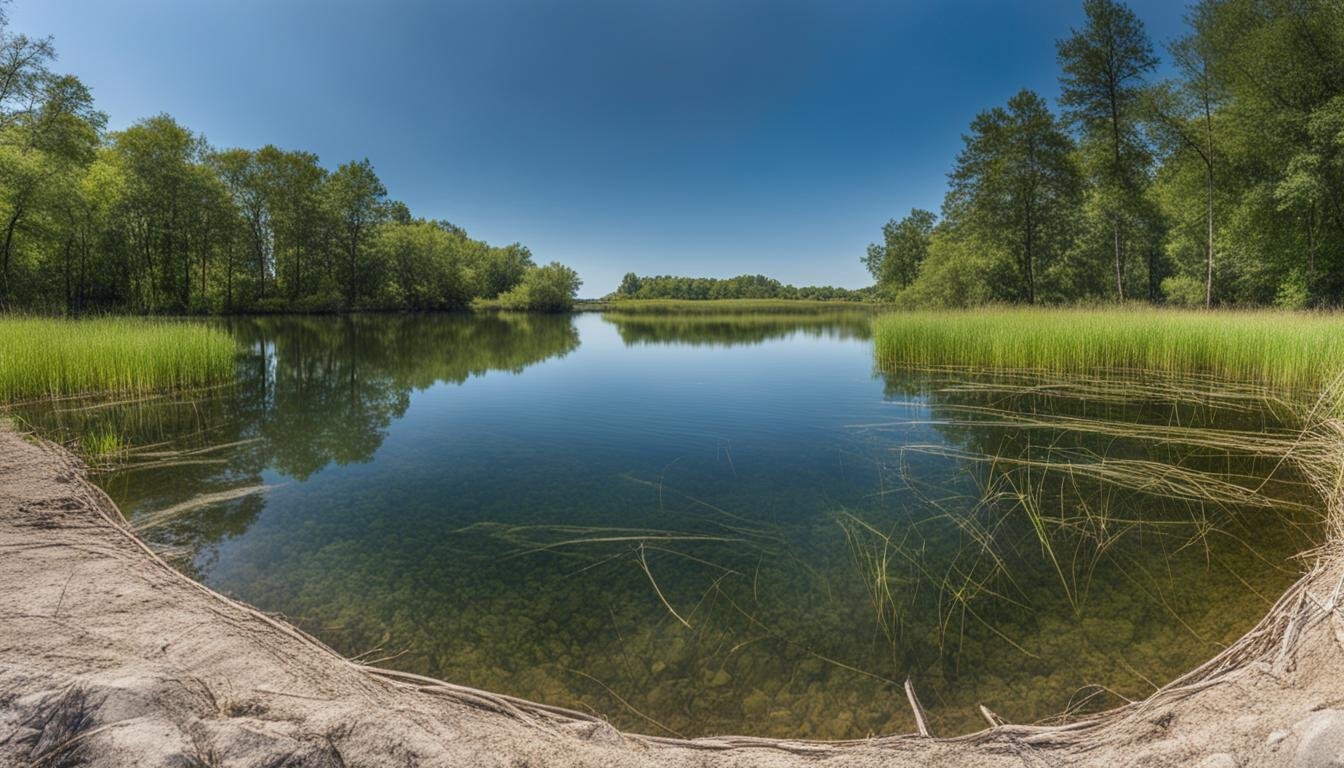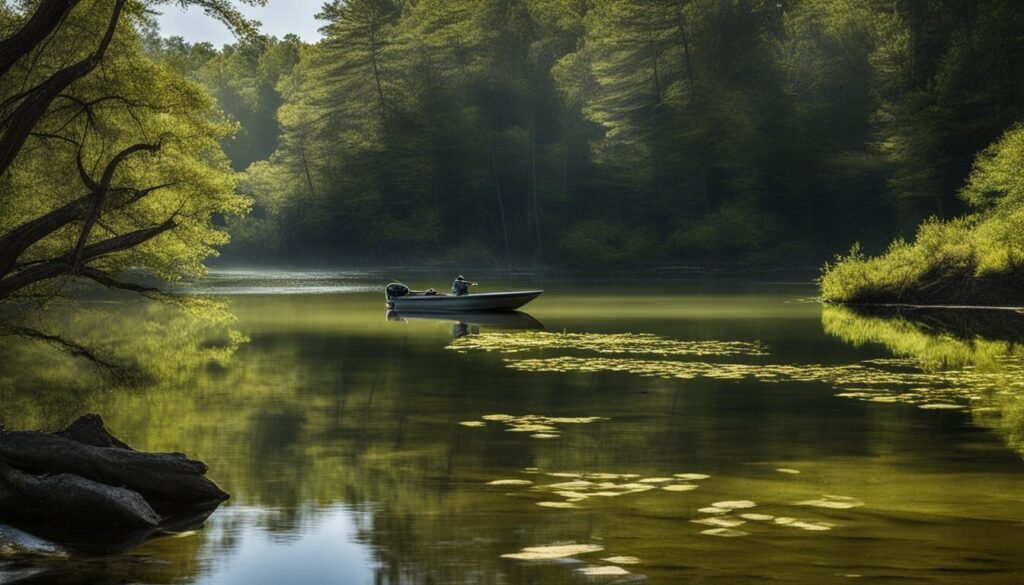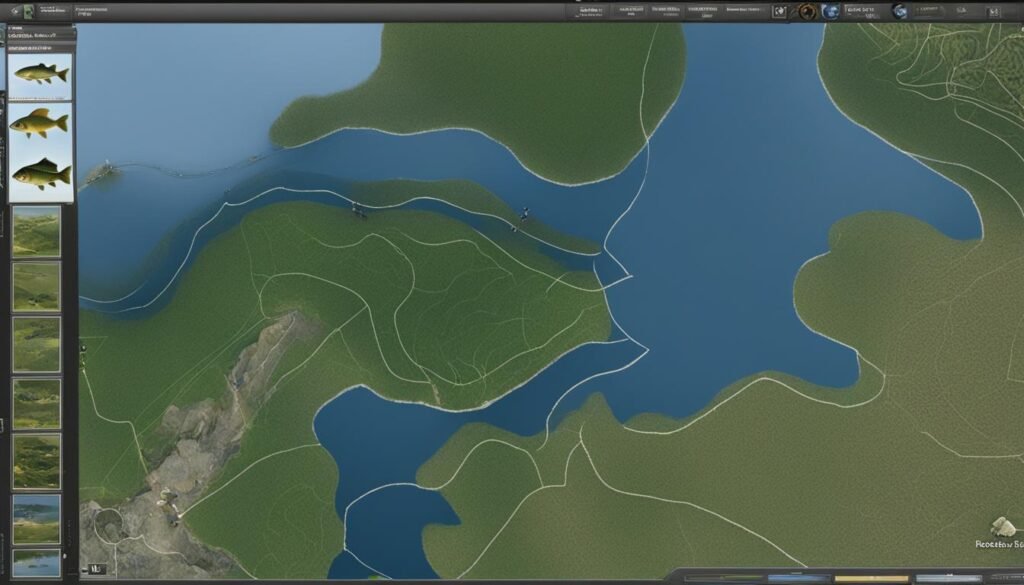Whether you’re fishing in lakes, rivers, or ponds, knowing where to look for bass can make all the difference. From northern bays to river channels and hard cover areas, we’ll explore the diverse habitats that bass tend to favor. We’ll also discuss how seasonal patterns and innovative tools like Google Earth and lake maps can further refine your search for bass. By incorporating these bass fishing tips into your strategy, you’ll be well-equipped to reel in those trophy-sized bass!

Northern Bays – Ideal Spawning Locations for Bass
As an angler looking to find the best bass habitats, it’s important to understand where to focus your efforts during the spawning season. One of the prime locations for spawning bass is the northern bays of lakes. These bays offer the perfect conditions for bass to reproduce and thrive.
Why are northern bays so ideal for spawning bass? It all comes down to warm water. In the spring, bass are drawn to warmer areas in order to spawn. Northern bays tend to be the warmest spots in the lake, thanks to their exposure to sunlight and fast warming rates.
By targeting these shallow, warm bays, you can significantly increase your chances of finding active, feeding fish during the spawn. Bass are attracted to these areas because they provide the necessary conditions for successful reproduction.
So, how can you make the most of fishing in northern bays? Here are some bass fishing tips to help you maximize your success:
- Focus on shallow areas within the bay, where the water temperature is warmer.
- Look for submerged vegetation, such as weeds and grass, as it provides cover and attracts baitfish.
- Use lures and baits that mimic the prey species present in the bay.
- Stay patient and persistent, as bass can be finicky during the spawning process.
River/Creek Channels – Underwater Highways for Bass
Bass are known to utilize river and creek channels as strategic routes during their spring migration from deep wintering holes to shallow pre-spawn areas. These channels act as underwater highways, guiding the bass along a clear path.
By following these river and creek channels, you can intercept bass as they make their way towards their spawning grounds. The predictable nature of these pathways makes it easier for anglers to target the bass along their migration journey.
Focusing your efforts on these areas can significantly increase your chances of locating active and feeding fish during the spring spawn. The well-defined channels serve as reliable indicators of where bass are likely to be found, allowing you to plan your fishing strategy accordingly.
The Benefits of River/Creek Channels for Bass Fishing
- Clear navigation: River and creek channels provide a clear and defined path for bass, making them easier to intercept.
- Concentration of fish: These channels attract a concentration of migrating bass, increasing your chances of catching multiple fish.
- Natural cover: Channels often feature natural cover, such as submerged vegetation or fallen trees, which can attract bass seeking shelter.
- Structure and depth variation: River and creek channels offer variations in depth and structure, which attract both predatory bass and the forage they feed on.
- Year-round viability: River and creek channels remain productive fishing spots throughout the year, providing opportunities beyond just the spring spawn.
To make the most of fishing river and creek channels, consider using techniques such as vertical jigging, crankbaits, or soft plastics that mimic natural forage in these habitats. Experimenting with different lures and fishing depths can help you pinpoint the most effective approach for catching bass along these underwater highways.
Hard Cover – Attracting Bass on Sunny Days
When the sun is shining bright, bass have a natural inclination to seek out areas that retain heat. These warm pockets provide them with the optimal conditions to regulate their body temperature and stay comfortable. As an angler, understanding this behavior can greatly enhance your chances of attracting bass on sunny days.
Rocks, metal pilings, and wood are excellent examples of hard cover that can hold heat from the sun. These structures act as natural heaters, absorbing and radiating warmth throughout the day. Bass are often drawn to these areas, not only for the heat but also because they offer shelter and protection.
By strategically targeting these hard cover spots, you can increase your success in catching bass. Look for rocky shorelines, submerged metal structures like bridge pilings, and fallen trees in the water. These locations are likely to attract bass and provide a prime feeding ground.
Bass Fishing Tips for Targeting Hard Cover:
- Use baits that mimic the natural prey found in those areas, such as crayfish, baitfish, or worms.
- Cast your bait close to the structure and retrieve it slowly, imitating the movement of injured or vulnerable prey.
- Pay attention to any irregularities in the cover, as bass may position themselves near these points of ambush.
- Consider using a fish finder or studying a detailed lake map to locate specific areas with hard cover.
Water Inflow – Prime Locations for Prespawn Bass

When it comes to targeting prespawn bass, one prime location to consider is areas where water is flowing into a lake. These water inflows, such as creek mouths and warm water discharges, can be hotspots for bass activity. They provide a source of fresh water, food, and increased oxygen levels, making them attractive to bass, especially in the backs of creeks and bays.
By focusing your fishing efforts on these areas, you can increase your chances of finding active, feeding fish during the spring spawn. Bass tend to congregate near these water inflows, taking advantage of the various benefits they offer.
To maximize your success, try targeting creek mouths, where the rushing water creates a current that can concentrate bass. Additionally, warm water discharges from power plants or sewage treatment facilities can create a temperature gradient that attracts bass looking for warmer water during the cooler spring months.
- Focus on creek mouths and warm water discharges.
- Look for areas with increased water flow.
- Consider the temperature gradient created by warm water discharges.
- Pay attention to oxygen levels and food availability.
Secondary Points – Staging Areas for Prespawn Bass
Before actually pushing up to spawn, female bass often linger in deeper water near spawning grounds. During this time, male bass wait in shallower water for the females to arrive, while the females remain in deeper water for safety. Anglers can target these big female bass by focusing on secondary points near spawning grounds. These points provide prime staging areas for prespawn fish.
Docks – Ideal Spawning Habitat for Bass
Docks offer shade, structure, and shallow water, making them popular areas for targeting bass throughout the spawning process. Docks near shallow flats or with hard bottoms like rocks, gravel, or sand provide ideal spawning habitat for bass. By creating ideal bass habitat, these areas become attractive to the fish during the spawning season.
When targeting spawning bass around docks, it’s important to use finesse baits and approach the area with caution. The fish can be easily spooked, so casting from a distance while carefully presenting your bait can help maximize your chances of success. By paying attention to the bass habitat under and around docks, you can increase your odds of finding active, feeding fish during the spawn.
Understanding Seasonal Patterns – Key to Success
When it comes to successful bass fishing, understanding the seasonal patterns is essential. Bass change their locations and feeding patterns throughout the year in response to factors such as water temperature. By gaining insights into these patterns, you can predict where bass are likely to be and what they are likely to feed on, ultimately improving your chances of success on the water.
To help you navigate the different seasons and adjust your fishing strategy accordingly, this article will provide detailed information on how bass behave during each season. Whether it’s the spring spawn or the winter slowdown, you’ll gain valuable tips and tactics for targeting bass in different habitats and conditions.
As the seasons change, bass will seek out specific habitats that provide the ideal conditions for feeding and shelter. By understanding their preferences during each season, you can effectively target them in their preferred habitats, increasing your chances of a successful fishing trip.
Throughout the article, you’ll find expert advice and practical bass fishing tips to help you optimize your angling techniques. From the best lures and presentations to the most effective techniques for each season, you’ll gain valuable insights to enhance your bass fishing skills.
Remember, becoming a successful bass angler goes hand in hand with understanding the seasonal patterns and adjusting your fishing strategy accordingly. With the knowledge and tips provided in this article, you’ll be well-equipped to tackle any season and increase your chances of reeling in your next big catch.
Seasonal Patterns and Bass Fishing Tips
- Spring: Target spawning bays and use finesse baits.
- Summer: Fish deep structures and use topwater lures in low light conditions.
- Fall: Look for schools of baitfish and use crankbaits near cover.
- Winter: Slow down your presentation and target deep water structures.
Using Google Earth to Find Fish – A Valuable Tool
Google Earth is a valuable resource for bass anglers looking to find fish and create ideal bass habitat. With its advanced aerial imagery and zoom capabilities, Google Earth allows you to explore new lakes and identify potential bass habitats with ease.
Using Google Earth, you can zoom in on specific locations and analyze the surrounding areas for bass habitat. Look for structures such as rock piles, creek channels, and points, as these are often preferred locations for bass to hide and feed. By identifying these key features, you can increase your chances of finding active, feeding fish.
One of the advantages of using Google Earth is the ability to drop waypoints and save locations for future reference. This feature allows you to create a game plan before hitting the water, ensuring that you target the most promising areas. By pre-selecting your fishing spots, you can maximize your time on the water and increase your chances of success.
Whether you’re a beginner or an experienced angler, Google Earth can provide valuable insights into bass habitat and help you refine your fishing strategy. Take advantage of this powerful tool to enhance your bass fishing experience and create the ideal bass habitat.
Using Your Graph’s Lake Map to Refine Your Search

A quality map of the lake, whether in physical or digital form, is essential for refining your search for bass. Navionics and other mapping tools provide detailed information about underwater structures, including ledges, creek channels, and points. By analyzing these maps, you can identify prime fishing spots and plan your fishing strategy accordingly.
Using lake maps effectively can maximize your chances of finding bass. Here are some tips to help you make the most of your lake map:
- Familiarize yourself with the legend: Lake maps often come with legends that explain the various symbols and markings used to represent different features. Take some time to understand what each symbol means so you can interpret the map accurately.
- Identify potential hotspots: Look for areas on the map that indicate potential bass habitat, such as underwater structures, drop-offs, and points. These areas are likely to hold fish and should be your primary focus when fishing.
- Pay attention to water depth: Lake maps often display contour lines that show changes in water depth. Knowing the depth of the water can help you target specific areas where bass may be holding, such as shallow flats or deep holes.
- Mark promising locations: As you analyze the map, use waypoints or markers to highlight areas that look promising for bass fishing. These markers will serve as a reference when you’re on the water, helping you navigate to the best spots without wasting time.
Using your graph’s lake map to refine your search will give you a strategic advantage when it comes to finding bass. By understanding the underwater structures and potential bass habitats, you can plan your fishing trips effectively and increase your chances of success.
Go Stealth – Tips for Quietly Approaching Bass
When it comes to bass fishing, stealth is key. To avoid spooking the bass, it’s important to minimize noise and disturbance while approaching them. Experienced anglers recommend staying off the trolling motor in tight quarters as the noise and vibrations can alert the fish. It’s also best to avoid making loud noises on the boat that could startle the bass.
One effective tactic is to use carpets or other materials to deaden sound on exposed metal surfaces. By muffling any noise produced by your equipment or gear, you can maintain a quiet presence on the water. This will help you get closer to the bass without alerting them to your presence.
Another strategy is to stalk the bank and avoid close approaches to the shoreline. Bass tend to be more cautious near the shallows, so keeping your distance can prevent them from sensing your presence. By maintaining a stealthy approach, you can increase your chances of sneaking up on the bass and having a successful fishing experience.
Remember, practicing stealth techniques is not only about getting closer to the bass but also about respecting their natural habitat. By minimizing disturbances, you can ensure a more harmonious fishing experience while preserving the bass habitat for future generations of anglers.
Looking For More Bass Content?
Look through our other articles about bass fishing to learn more and find new tips, techniques and tricks
